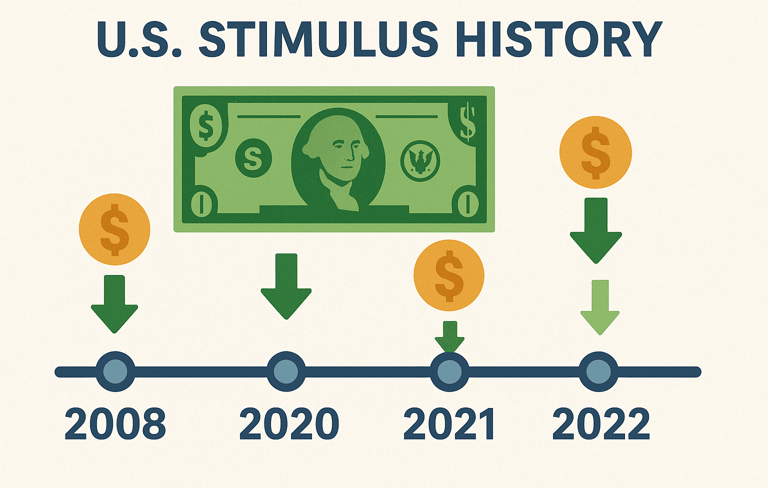US_Stimulus_History
Stimulus Packages in the USA: Meaning, History, and Impact
What is a Stimulus Package?
A stimulus package is a set of policies enacted by the government to simulate growth in difficult economic conditions. A slowing economy means people spend less, companies earn less and unemployment rises. In those cases, the government injects various kinds of financial aid into the system to stimulate demand and create jobs and restore equilibrium in the economy.
Stimulus can include:
- Direct cash payments (stimulus checks): Money supplied directly to individuals.
- Tax cuts and credits: Enabling people to retain a better share of their income.
- Unemployment benefits: Aiding the newly unemployed.
- Business support programs: Loans, grants and subsidies to help businesses stay afloat.
- Infrastructure investment Building roads, bridges and schools to promote jobs and growth.
The principle stems from Keynesian economics, which posits that when the economy craters, government spending is needed to keep the economy afloat until private demand rebounds.
History of The US Stimulus Early in the USA
Great Depression - New Deal (1930s)
The early use of stimulus on a large scale in the U.S. was during the Great Depression. Millions were out of work, banks collapsed and businesses shut down. President Franklin D. Roosevelt introduced the New Deal that includes:
- Programs for public works to provide jobs.
- The Social Security Act (which provided retirement and unemployment benefits).
- Infrastructure works such as dams, bridges and rural electrification.
Post-War Stimulus and Investments (1940s–1950s)
The United States poured money into housing and education after World War II with the G.I. Bill, and into infrastructure through the Interstate Highway System. Those programs were not called stimulus packages, but they had identical effects — lifting growth, generating jobs, helping shape the modern American economy.
Tax Cuts in the 1960s and ’80s
- Kennedy–Johnson tax cuts (1964): Intended to boost consumer spending and investment.
- Reagan’s Economic Recovery Tax Act (1981): A large tax cut in the service of jump-starting the economy with supply-side policy.
Modern U.S. Stimulus Packages
1. The 2008 Financial Crisis.
The collapse of the housing market led to the Great Recession — one of the deepest downturns since the Great Depression. The government responded with:
- Economic Stimulus Act of 2008 (George W. Bush): Tax rebates to individuals up to $600 each to boost spending.
- American Recovery and Reinvestment Act (ARRA, 2009 — Barack Obama): A $787 billion bill that contained infrastructure spending, tax cuts, expanded unemployment benefits and overall assistance to the states.
2. The COVID-19 Stimulus (2020–2021)
The pandemic led to huge job losses and shutdowns of the economy. In the U.S., it responded with history’s largest set of stimulus efforts:
- CARES Act (March 2020): $2.2 trillion package that included $1,200 stimulus checks, enhanced unemployment benefits and the Paycheck Protection Program (PPP) to help businesses keep workers on their payrolls.
- Consolidated Appropriations Act (December 2020): $900 billion with $600 checks, rental aid and unemployment relief.
- American Rescue Plan (March 2021): $1.9 trillion for $1,400 stimulus checks, expanded child tax credits, vaccine distribution and aid to state and local governments.
Stimulus of 2025: What Are We Dealing With?
There are no new federal stimulus checks in the works (yet). However:
- The I.R.S. continues to work through back payments for those who have missed previous stimulus checks, through the Recovery Rebate Credit.
- Some states, including California, New York and Colorado, have set up their own state-level assistance payments on an ad-hoc basis but these are typically much smaller than federal programs.
There are ongoing discussions in Congress about targeted relief for seniors, housing assistance, and student debt, but no nationwide stimulus bill has been passed recently.
Benefits of Stimulus Packages
Those in favor posit that there is an imperative need to inject stimulus simply because it:
- Stops an economic meltdown in crisis.
- Puts money directly in people’s pockets to pay for rent, groceries and bills.
- Protects businesses and jobs during downturns.
- Accelerates the recovery so there’s less long-term damage to the economy.
Criticisms of Stimulus
Critics highlight potential downsides:
- Adds to the national debt, burdening future budgets.
- Can leads to inflation if too much money is chasing too few goods.
- Risk of inequitable distribution, in which some groups benefit more than others.
- Temporary boost — stimulus alone cannot fix structurally broken economy.
FAQs About U.S. Stimulus Packages
1. How many stimulus checks were sent in the U.S.?
Between 2020 and 2021, there were three rounds of federal stimulus checks.
2. Are new stimulus checks coming in 2025?
As of now, there are no plans for new federal checks, though some states have smaller programs.
3. Who was eligible for stimulus checks?
Qualification was determined by income, filing status and dependents. For instance, people making less than $75,000 got the full payments.
4. What if I missed a stimulus check?
You can receive it as a credit via the Recovery Rebate Credit when you file your taxes.
Conclusion
The history of stimulus in the United States demonstrates how critical government action is during crises. From Roosevelt’s New Deal to Biden’s American Rescue Plan, these stimulus packages have been deployed to protect households and businesses and stabilize the economy.
Even as debates about debt and inflation continued, one thing was clear: in times of economic distress, stimulus is one of the single most potent tools that the United States government has to protect its people and its economy.



